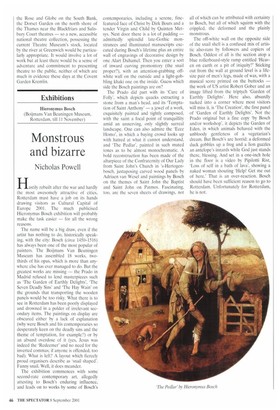Monstrous and bizarre
Nicholas Powell
Hastily rebuilt after the war and hardly the most awesomely attractive of cities, Rotterdam must have a job on its hands drawing visitors as Cultural Capital of Europe 2001. The much publicised Hieronymus Bosch exhibition will probably make the task easier — for all the wrong reasons.
The name will be a big draw, even if the artist has nothing to do, historically speaking, with the city: Bosch (circa 1450-1516) has always been one of the most popular of painters, The Boijmans Van Beuningen Museum has assembled 18 works, twothirds of his opus, which is more than anywhere else has ever managed to do. But the greatest works are missing — the Prado in Madrid refused to lend masterpieces such as 'The Garden of Earthly Delights', 'The Seven Deadly Sins' and 'The Hay Wain' on the grounds that transporting the wooden panels would be too risky. What there is to see in Rotterdam has been poorly displayed and drowned in a polder of irrelevant secondary items. The paintings on display are obscured either by a lack of explanation (why were Bosch and his contemporaries so desperately keen on the deadly sins and the theme of temptation, for example?) or by an absurd overdose of it (yes, Jesus was indeed the 'Redeemer' and no need for the inverted commas; if anyone is offended, too bad). What is left? A layout which fiercely proud organisers describe as 'snail shaped'. Funny snail. Well, it does meander.
The exhibition commences with some second-rate contemporary art, allegedly attesting to Bosch's enduring influence, and leads on to works by some of Bosch's contemporaries, including a serene, finefeatured face of Christ by Dirk Bouts and a tender Virgin and Child by Quinten Metsys. Next door there is a lot of padding — admittedly splendid late-Gothic monstrances and illuminated manuscripts executed during Bosch's lifetime plus an entire wall of engravings of decorative design by one Alart Duhamel. Then you enter a sort of inward curving promontory (the snail proper?), with an attention-grabbing offwhite wall on the outside and a light-gobbling khaki one on the inside. Guess which side the Bosch paintings are on?
The Prado did part with its 'Cure of Folly', which depicts quacks extracting a stone from a man's head, and its 'Temptation of Saint Anthony' — a jewel of a work, exquisitely painted and tightly composed, with the saint a focal point of tranquillity amid an unnerving, only slightly surreal landscape. One can also admire the 'Ecce Homo', in which a baying crowd looks up with hatred at what it cannot understand. and 'The Pedlar', painted in such muted tones as to be almost monochromatic. A bold reconstruction has been made of the altarpiece of the Confraternity of Our Lady from Saint John's Church in 's-Hertogenbosch, juxtaposing carved wood panels by Adriaen van Wesel and paintings by Bosch on the themes of Saint John the Baptist and Saint John on Patmos. Fascinating, too, are the seven sheets of drawings, not
all of which can be attributed with certainty to Bosch, but all of which squirm with the crippled, the deformed and the plainly monstrous.
The off-white wall on the opposite side of the snail shell is a confused mix of artistic also-rans by followers and copiers of Bosch. Oddest of all is the section atop a blue rollerboard-style ramp entitled 'Heaven on earth or a pit of iniquity?' Sticking Out from the wall at ground level is a lifesize pair of men's legs, made of wax, with a musical score printed on the buttocks — the work of US artist Robert Gober and an image lifted from the triptych 'Garden of Earthly Delights'. Here also, absurdly tucked into a corner where most visitors will miss it, is 'The Creation', the first panel of 'Garden of Earthly Delights'. Not the Prado original hut a fine copy 'by Bosch and/or workshop', it depicts the Garden of Eden, in which animals behaved with the unbloody gentleness of a vegetarian's dream. But Bosch's are horrid: a deformed duck gobbles up a frog and a lion guzzles an antelope's innards while God just stands there, blessing. And set in a one-inch hole in the floor is a video by Pipilotti Rist, 'Loss of self in a bath of lava', showing a naked woman shouting 'Help! Get me out of here.' That is an over-reaction. Bosch should have been sufficient reason to go to Rotterdam, Unfortunately for Rotterdam, he is not.


































































 Previous page
Previous page